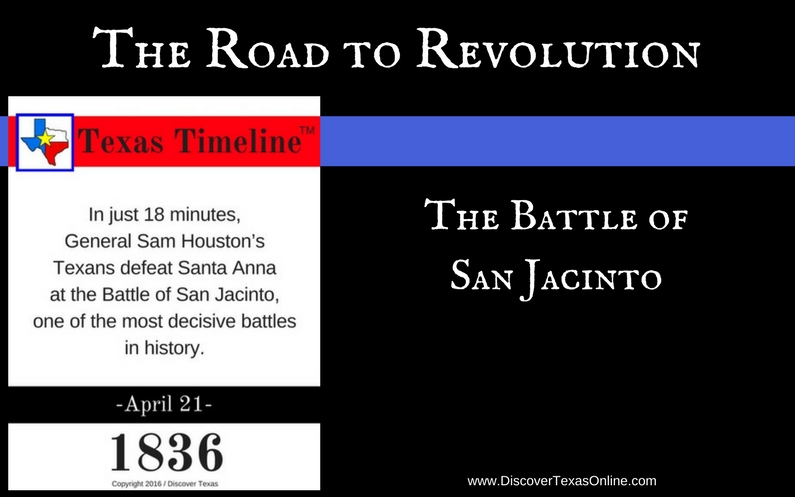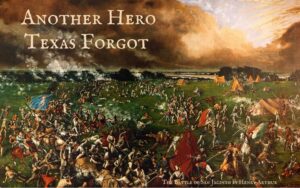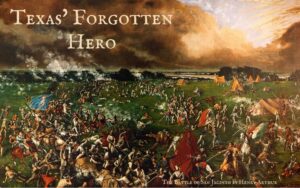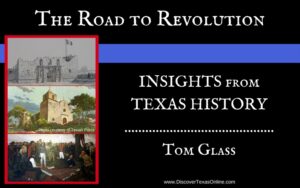
Houston began with approximately 1200 Texians in his volunteer army, but after the slaughter at the Alamo and the Goliad massacre, approximately 400 deserted him to get their families to safety in the runaway scrape. He might have hoped for a larger force, but this number represents 2%-3% of Texas population of 38,500 in 1836, which is only a little less that the proportion who normally serve in a country’s military. There are many theories about why Houston prolonged his retreat, but it is a fact that this tactic caused dissension. Texas President David Burnet even ordered Houston to stop his retreat, and Secretary of War Thomas Rusk urged him to take decisive action…and boy, did he!
Santa Anna marched his Mexican Army into Harrisburg (present-day Houston) April 15th and burned the town. On April 19th he pursued the retreating Texas provisional government into New Washington (Morgan’s Point) just in time to see Texas President David Burnet setting sail for Galveston. It was here that he captured Emily D. West–the “Yellow Rose of Texas”–before ransacking and burning the hotel and warehouses of her employer, James Morgan. In my imagination I can see her bravely staying at her post, as she’d given her word to do in her contract, before saving her passport and precious freedom papers from the flames as she and the other captives were dragged along to San Jacinto.
While this was happening, Houston’s volunteers, who had dwindled to about 700-900 by this time, reached the settlement of New Kentucky (near present-day Tomball, Texas) where the road from Washington-on-the-Brazos forked. One route led to safety in Louisiana; the other to the smoldering site of Harrisburg. The “Which Way Tree” stood at the junction, one branch pointing along each route. Here the final decision was made to march toward the smoldering remains of Harrisburg and a decisive confrontation with Santa Anna’s army that was surely certain.
On April 20th, the day before the battle, Col. Sidney Sherman “went off half-cocked”, engaging the enemy against orders and costing the lives of one Texan and several horses. During the skirmish, Private Mirabeau B. Lamar saved the life of Thomas Rusk as well as another soldier. General Houston was so disgusted with Sherman that he removed him from command, granting Lamar a field promotion to the rank of Colonel and putting him in command of the cavalry on the day of battle.
I’m a sucker for historical detail as well, especially if it adds sensory elements to the story. If you’re similarly nerdy about history, you might want to know that Houston had his men play Come to the Bower as they marched. There were no fifes or drums in the Texas Army, but there were fiddlers–Daniel Davis and his son, George Washington Davis–who played the tune on that day, accompanied, perhaps, by mouth harps. As Houston marched his troops to their battle positions, he requested Come to the Bower because it was a bar ditty rather than a military song. By some accounts, Houston hoped that the lighthearted tune might convince Santa Anna that he was only marching his men out for some much-needed drilling rather than preparing to attack.
Mexican General Martin Perfecto de Cos was Santa Anna’s cousin (and, to my way of thinking, arrogance must have been a family trait, but I digress). He marched across Vince’s Bayou on the morning of April 21 with approximately 500 men, bringing the Mexican forces to about 1200-1500 in number. Houston sent a small group led by Deaf Smith to burn the bridge. The destruction of the bridge did NOT prevent at least one major group of Mexican reinforcements from arriving, though its destruction did cut off the only route for further reinforcements. It also cut off the means of escape and retreat for either army. Once Vince’s Bridge was destroyed, Texas independence would have to be decided at San Jacinto.
After Deaf Smith reported that the bridge was destroyed, Houston decided to launch his attack at 3:30 in the afternoon, during siesta when, for some reason, Santa Anna did not even post look-outs. Juan Seguin’s brave Tejano volunteers wore playing cards in their hatbands to help the Texians differentiate them from the Mexican soldiers. Original documents tell us that Sam Houston rode a dapple grey horse into battle. He’d purchased it en route to San Jacinto from Isom Parmer for 400 Mexican silver dollars. Sadly, as Houston led the charge into battle the gray was shot dead, perhaps by the same musket ball that shattered Houston’s left ankle. (Despite the famous painting and a good deal of quibbling among historians, a letter from Houston himself as well as a book written by his son specifically mentions the left leg.) General Houston then grabbed the horse of a slain Mexican officer and remounted, but that horse, too, was shot out from under him. (Actually, it fell on top of him. I haven’t been able to find out if it fell on the same leg that was shattered earlier.) Houston somehow managed to get free and mounted a third horse, which he rode for the remainder of the battle. April 21, 1836 was a bad day for horses!
Fortunately, it was a very good day for the Texian Army. The battle was brief–only about 18 minutes from start to finish. The Mexican Army saw 630 killed in action, about 200 wounded, and 700 rounded up as prisoners of war. By contrast, the Texians only had 9 killed or mortally wounded with an additional 30 wounded. It was, in short, a stunning victory. Historians agree that the Battle of San Jacinto was among the Top Ten most decisive victories in all of history!
Teaching Tip:
- Research the boundaries of Texas in 1836 to see just how much land Santa Anna lost on this day!
- Discuss with your students the importance of constant vigilance.
- If possible, visit the San Jacinto Battleground State Historic Site and/or the San Jacinto Monument and Museum.



